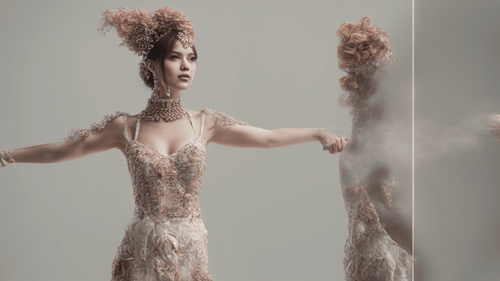
Imagine a world where words come to life in vibrant visuals, where language seamlessly transforms into stunning imagery, and ideas are illustrated with the stroke of a virtual brush. Welcome to the realm of AI that turns words into pictures, an innovative fusion of artificial intelligence and artistic expression. In this comprehensive article, we delve deep into the intricacies of this cutting-edge technology, its mechanisms, applications across industries, and the limitless creative possibilities it brings. Let's embark on a journey where language and art converge, guided by the transformative power of Picasso AI.
Understanding AI's Artistic Evolution
The Fusion of Language and Visuals: How AI Turns Words into Pictures AI, or artificial intelligence, is the driving force behind an array of revolutionary advancements, and one such marvel is its ability to turn words into pictures. At the heart of this innovation lies a complex interplay of natural language processing (NLP), machine learning, and artistic algorithms. By deciphering the semantic and contextual nuances of written text, AI translates textual input into captivating visual representations.
Decoding the Mechanics of AI-Powered Visual Translation
-
Language Comprehension and Semantic Analysis: The AI begins by comprehending the written text, extracting its meaning, and identifying key concepts.
-
Conceptual Mapping: Through a web of interconnected data points, the AI maps words to relevant visual elements, creating a semantic bridge between language and imagery.
-
Artistic Rendering: Leveraging advanced artistic algorithms, the AI renders visuals that capture the essence of the text, infusing creativity and style into the process.
-
Real-Time Iteration: The technology continuously refines its output based on user interactions and feedback, ensuring an evolving and dynamic visual experience.
Applications Across Diverse Industries
AI Turns Words into Pictures: Unleashing Creative Potential Across Sectors The impact of AI that turns words into pictures extends far beyond artistic expression. Its versatile applications span various industries, revolutionizing communication, marketing, education, and more. Let's explore how this transformative technology is making waves:
1. Marketing and Advertising: Captivating Visual Campaigns
In the realm of marketing, AI-generated visuals are redefining the way brands connect with their audience. Marketers harness the power of AI-generated imagery to craft visually compelling campaigns that resonate with consumers on a profound level.
2. Education and E-Learning: Visualizing Knowledge
Educators and e-learning platforms integrate AI-generated visuals to simplify complex concepts, making learning more engaging and accessible. Visual representations of textual content enhance comprehension and retention, catering to diverse learning styles.
3. Content Generation: From Text to Engaging Imagery
Content creators and writers find a powerful ally in AI that transforms their written words into captivating visuals. This synergy of language and art enhances the overall impact of content, catering to today's visually-oriented audiences.
4. Data Visualization: Bridging Insights and Imagery
In the realm of data analysis, AI turns statistical data and insights into visually appealing charts, graphs, and infographics. This dynamic approach to data visualization facilitates quicker and more intuitive comprehension of complex information.
5. Entertainment and Gaming: A Visual Odyssey
The entertainment industry embraces AI-generated visuals to enhance the immersive experience of movies, video games, and virtual reality. AI breathes life into fictional worlds, translating narrative elements into captivating visual spectacles.
6. Healthcare and Medical Imaging: Enhancing Diagnostic Accuracy
AI's ability to transform medical texts into detailed visual representations is revolutionizing diagnostics. Physicians can visualize complex medical information, aiding in accurate diagnosis and treatment planning.
FAQs: Demystifying AI's Creative Transformation
What is the underlying technology behind AI that turns words into pictures? AI that turns words into pictures relies on a combination of natural language processing (NLP), semantic analysis, and artistic algorithms to translate textual input into visually compelling imagery.
Can AI-generated visuals replace traditional art forms? AI-generated visuals complement traditional art forms by offering a new dimension of creativity. While AI can produce stunning visuals, the essence of human artistic expression remains irreplaceable.
How is AI-generated imagery personalized for individual users? AI employs real-time iteration and user feedback to tailor generated visuals according to individual preferences, ensuring a personalized and engaging experience.
Is there a risk of AI-generated visuals perpetuating stereotypes or biases? AI's creative output is influenced by the data it's trained on. To mitigate biases, developers implement rigorous data filtering and bias-checking processes to ensure fair and inclusive visual representations.
Can AI-generated visuals evoke emotional responses in viewers? Yes, AI-generated visuals are designed to evoke emotional responses by infusing artistic styles and aesthetics into the imagery, creating a deeper connection with viewers.
What does the future hold for AI-powered creative technologies? The future promises an exciting evolution of AI-powered creative technologies, with advancements in emotion recognition, style adaptation, and interactive storytelling, opening new realms of artistic exploration.
Embracing a Creative Future: The Unbounded Horizons of AI and Art
As we traverse the realm of AI that turns words into pictures, it becomes evident that the convergence of language and art holds limitless potential. This technology transcends boundaries, opening doors to creativity that were once unimaginable. Whether it's revolutionizing marketing strategies, democratizing education, or adding depth to entertainment experiences, AI's transformative power is reshaping industries and enriching human interaction. With each stroke of the virtual brush, AI paves the way for a more visually captivating and emotionally resonant world, where words truly do become pictures.
In conclusion, AI that turns words into pictures is a testament to human ingenuity and technological advancement. Through the interplay of language comprehension, semantic analysis, and artistic rendering, AI transforms textual input into captivating visuals that span various industries. From marketing to education, content creation to healthcare, the applications of this technology are as diverse as they are impactful. As we gaze into the future, the horizons of AI and art continue to expand, offering a glimpse into a world where creativity knows no bounds. So, embrace the journey, where AI's brush strokes breathe life into words, and embark on an artistic odyssey like no other.